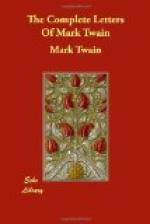But Lang seems never to have sent the notes. The copying would have been a tremendous task, and perhaps he never found the time for it. We may regret to-day that he did not, for Mark Twain’s article on the French author’s Joan would have been at least unique.
Samuel Clemens could never accustom himself to the loss of his wife. From the time of her death, marriage-which had brought him his greatest joy in life-presented itself to him always with the thought of bereavement, waiting somewhere just behind. The news of an approaching wedding saddened him and there was nearly always a somber tinge in his congratulations, of which the following to a dear friend is an example:
To Father Fitz-Simon, in Washington:
June 5, ’08. Dear father Fitz-Simon,—Marriage—yes, it is the supreme felicity of life, I concede it. And it is also the supreme tragedy of life. The deeper the love the surer the tragedy. And the more disconsolating when it comes.
And so I congratulate you. Not perfunctorily, not lukewarmly, but with a fervency and fire that no word in the dictionary is strong enough to convey. And in the same breath and with the same depth and sincerity, I grieve for you. Not for both of you and not for the one that shall go first, but for the one that is fated to be left behind. For that one there is no recompense.—For that one no recompense is possible.
There are times—thousands of times—when I can expose the half of my mind, and conceal the other half, but in the matter of the tragedy of marriage I feel too deeply for that, and I have to bleed it all out or shut it all in. And so you must consider what I have been through, and am passing through and be charitable with me.
Make the most of the sunshine! and I hope it will last long—ever so long.
I do not really want to be present; yet for friendship’s
sake and because
I honor you so, I would be there if I could.
Most
sincerely your friend,
S.
L. Clemens.
The new home at Redding was completed in the spring of 1908, and on the 18th of June, when it was entirely fitted and furnished, Mark Twain entered it for the first time. He had never even seen the place nor carefully examined plans which John Howells had made for his house. He preferred the surprise of it, and the general avoidance of detail. That he was satisfied with the result will be seen in his letters. He named it at first “Innocence at Home”; later changing this title to “Stormfield.”
The letter which follows is an acknowledgment of an interesting souvenir from the battle-field of Tewksbury (1471), and some relics of the Cavalier and Roundhead Regiments encamped at Tewksbury in 1643.
To an English admirer:




